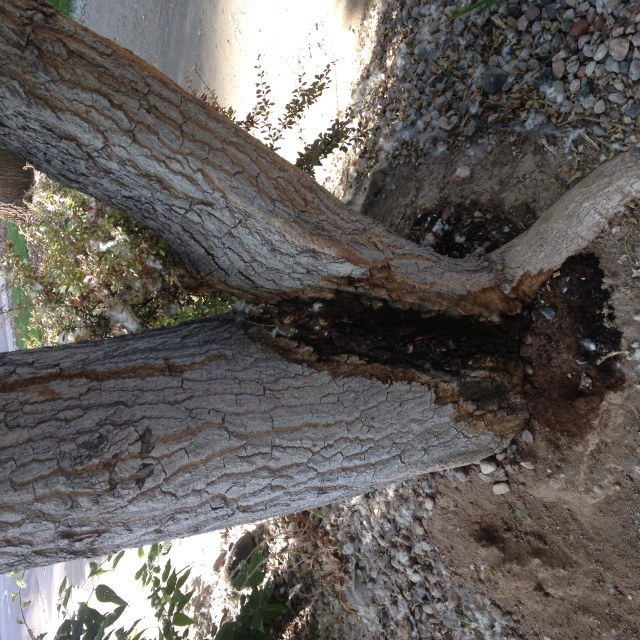Question
 Sap from cotton
Sap from cotton
Hi Jim,
Do cotton trees ooze sap? See picture. What does this mean? Also, the tree is leaning on my property (this is a neighbor's tree).
AnswerSounds like it could be a disease called slime flux. The pressure of the gases from the flux are able to escape at the weak point where the two trunks join.
Wetwood and slime flux are poorly understood tree disease problems. Wetwood is an internal bacterial infection in the wood of host trees. Slime flux is an external bleeding of sap typically associated with such infections. Concern is sometimes justified as wetwood and slime flux can cause noteworthy debilitating effects on infected trees including some dieback or decline, and an inability for wounds or pruning scars to form callus tissue for healing.
Recognition: Wetwood and slime flux are most often recognized by the oozing, bleeding, or fluxing of sap from bark fissures, pruning scars or wounds on the stems or branches of infected trees. Fluxing often occurs in branch crotches resulting from the tearing of tissues at these junctures by excessive branch weight, wind, etc. The oozing sap is usually dark brown, frothy or slimy and foul smelling soon after it is exposed to the air due to the activity of certain bacteria, yeast and other fungi by which it is rapidly colonized - hence the name slime flux. Slime flux, when profuse, characteristically flows downward from its points of emergence, and upon drying leaves a light gray to whitish incrustation on the surface of the bark. Due to its oftentimes highly alkaline nature, slime flux frequently results in the death of turf, shrubs, and plants on which it drips beneath infected trees.
Internally, wetwood is typically characterized by dark brown discolored wood which appears circular in cross section and wet or water-soaked. This wet wood is also characteristically malodorous, much like the normally associated slime flux.
Infection Biology:
The bacteria associated with wetwood and slime flux are common soil and water inhabitants. These organisms presumably gain entry into susceptible stem-wood tissues through wounds or pruning scars via certain insects, pruning tools, birds, and wind. Additional infections appear to be possible through direct root penetration or colonization of root wounds. Once established within the host the bacteria multiply and colonize the tree's central heartwood core. To a limited extent, the bacteria may also colonize portions of the outer, sapwood tissues. The metabolic activities of the bacteria within infected wood tissues generate a variety of gases, predominantly methane, nitrogen, and carbon dioxide. These gases, when confined within the wood tissues, produce unusually high pressures which force the sap outward through wounds and branch stubs giving rise to the readily identifiable, external slime flux.
Control: Control of wetwood and slime flux in forest tree stands is impractical. Infected ornamental trees may be helped by pruning declining branches, and fertilizing to promote tree vigor and wound closure. Installation of copper or semi-rigid plastic drain tubes to lower stem pressures and drain excess fluid or sap has been useful in many cases. Drain tubes should be tightly fitted and installed on an upward slant into the infected wood well below bleeding wounds or branch scars to a depth nearly reaching the tree's opposite side. Tubes should extend outward far enough to prevent dripping on the bark of the tree. Presumably, some type of small holes or perforations on the upper sides of drain tubes will aid the pressure release and draining processes. Avoiding tree injuries and pruning trees properly with clean, uncontaminated pruning equipment are also recommended for minimizing wetwood and slime flux infections.
There is no known effective control for slime flux. Inserting drain tubes around the affected area is no longer recommended. It may only help spread bacterial population within the tree and create wounds conducive to the entry of wood decaying fungi. Preventative measures such as avoiding moisture stress, proper pruning and adequate fertilization may help invigorate trees.
I would suggest that the tree be fertilized tree with 10-10-10 fertilizer at the rate of 1 lb per inch of trunk diameter scattered around the tree and watered in good. fertilize just before a rain storm and you will not need to water.
I would also spray the area with an insecticide called Onyx or Merit this will kill any insect that may try to take advantage of the wound as an entry point. This will stop Borer type insects from entering the wound and causing decay in the trunk. . IF you have an insecticide called Sevin on hand this will also work but will not last as long as the others.
Being the oozing is at a crotch it may over time weaked the area and could cause breakage. It was hard to tell by the picture where on the trunk the damage is located. I wopuld check the foliage and if there is good color and thick leaves the tree is healthy. If the foliage starts to thin then is maybe a sign of stress and the tree may need to be replaced. The fertilizer will help a great deal and I would recommend that this be done and this wil improve the health over all. I do understand it is not your tree but pass this indformation on to your neightbor and suggest the fertilizer.






